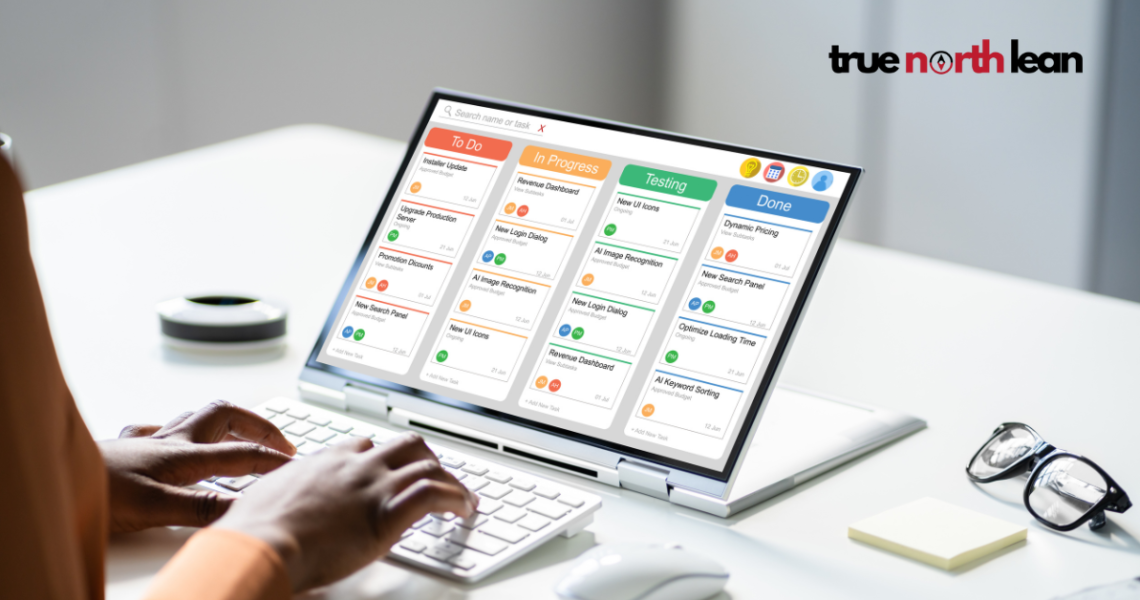Overcoming Kanban Scalability Challenges through Digitalization
Lean Digitalization | Kanban | Lean Technology
CASE STUDY – Reference from Planet Lean: How a manufacturing firm used digitalization to overcome the limits of manual kanban while preserving its pull-based lean culture.
From Push Planning to Pull Flow
Many organizations begin with a traditional push system, relying on centralized planning and forecast-driven scheduling. While this approach can work in stable environments, it often creates excess inventory, long lead times, and a lack of responsiveness to changing customer demand.
As part of its lean transformation, one company recognized the need to abandon push logic in favor of pull principles. By introducing kanban, it placed flow at the center of its operations. The change improved material management, reduced overproduction, and provided greater visibility across the shop floor. More importantly, it fostered a culture where continuous improvement became part of everyday work.
Kanban quickly became one of the organization’s lean cornerstones, enabling responsiveness and setting the stage for further improvement.
The Scalability Problem of Manual Kanban
In the early stages, manual kanban worked effectively. Employees were well trained, and the company maintained a strong lean culture. However, as production expanded and complexity increased, scalability issues emerged.
Maintaining the manual system became labor-intensive. Every few months, teams had to dedicate several days to update parameters, resize items, reprint cards, and redistribute them across production lines. This created administrative waste and consumed valuable time.
To cope with the workload, the company reduced the number of part numbers managed through kanban. This decision helped manage the burden but limited lean’s broader potential across the business.
Transition to Electronic Kanban
The turning point came with the decision to digitalize kanban rather than replace it. The company implemented an electronic kanban platform that preserved its pull-based logic while addressing maintenance challenges.
The digital solution introduced two critical capabilities:
- Automatic kanban sizing – Consumption data was collected and analyzed, with the system suggesting optimal quantities and adjustments in real time.
- Simplified card management – Updated disposable cards were automatically generated by the system, eliminating the need for large-scale reprints.
This meant the company could keep the same lean principles while significantly reducing the effort required to maintain the system.
A Scalable, Future-Ready System
With electronic kanban in place, the organization could finally manage all part numbers and production lines without limitations. Administrative work that once took days could be completed in a fraction of the time, allowing teams to redirect energy toward continuous improvement.
Real-time visibility into kanban cards also became a powerful strategic tool. Managers could quickly track the flow of materials, identify bottlenecks, and use accurate data when mapping value streams at both the component and departmental levels.
Opportunities for Integration
Beyond solving the immediate scalability challenge, digital kanban opened the door to broader opportunities. Integration with ERP systems, RFID portals, AGVs, and automated storage could create a fully connected production environment. Extending the system to suppliers and customers would allow pull principles to flow seamlessly across the entire supply chain.
Lessons for Lean Practitioners
This case study, adapted as a reference from Planet Lean, demonstrates that digitalization is not about replacing lean systems but strengthening them. By introducing technology carefully, the organization maintained the integrity of its pull system while solving a fundamental scalability issue.
For practitioners, the key lesson is that lean and digitalization are not in conflict. When applied thoughtfully, digital tools can remove barriers, eliminate waste, and allow continuous improvement to reach its full potential.

